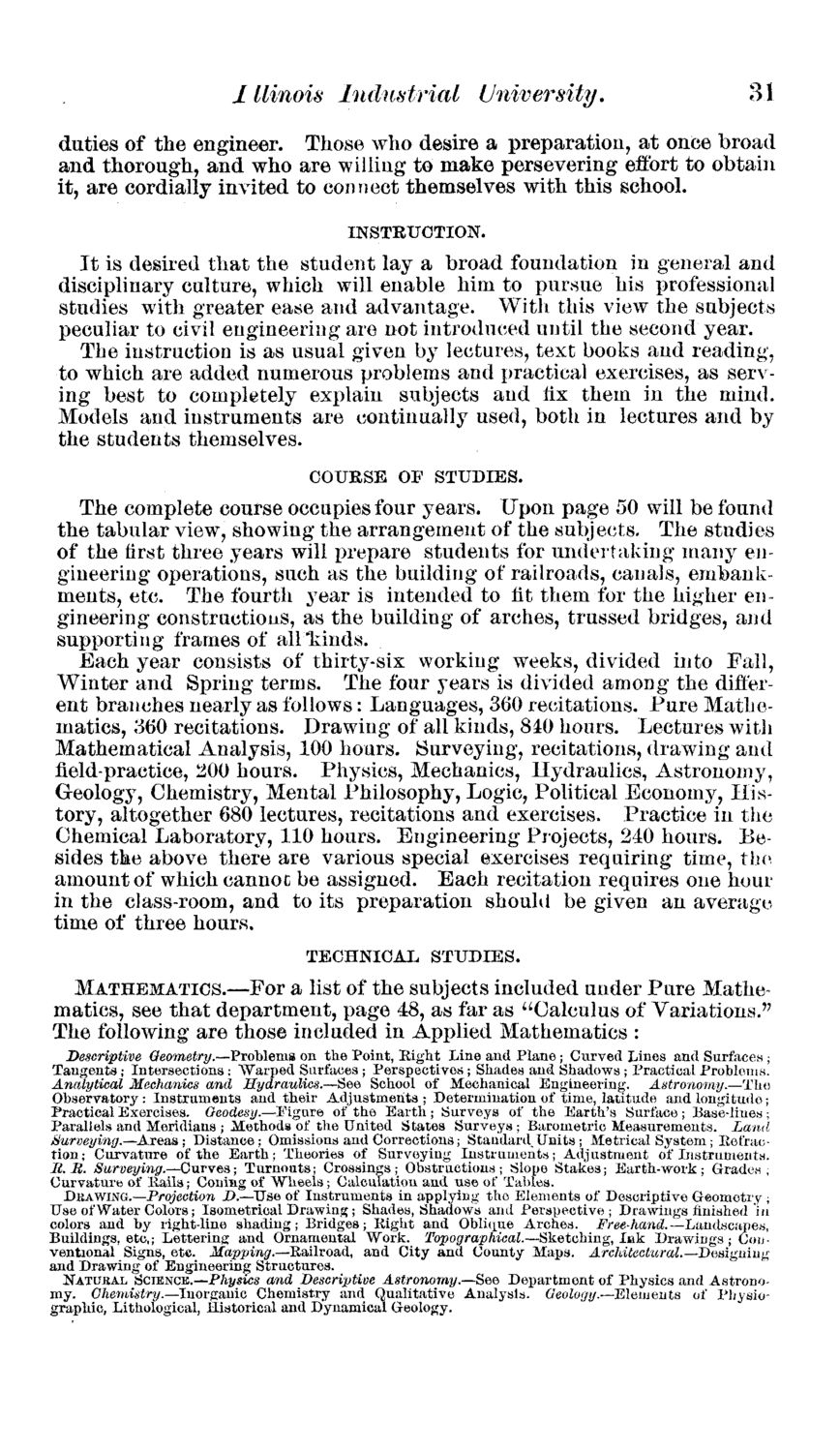| |
| |
Caption: Board of Trustees Minutes - 1874
This is a reduced-resolution page image for fast online browsing.

EXTRACTED TEXT FROM PAGE:
Illinois Industrial University. 31 duties of the engineer. Those who desire a preparation, at once broad and thorough, and who are willing to make persevering effort to obtain it, are cordially invited to connect themselves with this school. INSTRUCTION. It is desired that the student lay a broad foundation in general and disciplinary culture, which will enable him to pursue his professional studies with greater ease and advantage. With this view the subjects peculiar to civil engineering are not introduced until the second year. The instruction is as usual given by lectures, text books and reading, to which are added numerous problems and practical exercises, as serving best to completely explain subjects and hx them in the mind. Models and instruments are continually used, both in lectures and by the students themselves. COURSE OF STUDIES. The complete course occupies four years. Upon page 50 will be found the tabular view, showing the arrangement of the subjects. The studies of the first three years will prepare students for undertaking many engineering operations, such as the building of railroads, canals, embankments, etc. The fourth year is intended to fit them for the higher engineering constructions, as the building of arches, trussed bridges, and supporting frames of all "kinds. Each year consists of thirty-six working weeks, divided into Fall, Winter and Spring terms. The four years is divided among the different branches nearly as follows: Languages, 360 recitations. Pure Mathematics, 360 recitations. Drawing of all kinds, 8i0 hours. Lectures with Mathematical Analysis, 100 hours. Surveying, recitations, drawing and field-practice, 200 hours. Physics, Mechanics, Hydraulics, Astronomy, Geology, Chemistry, Mental Philosophy, Logic, Political Economy, History, altogether 680 lectures, recitations and exercises. Practice in the Chemical Laboratory, 110 hours. Engineering Projects, 240 hours. Besides the above there are various special exercises requiring time, the amount of which cannoc be assigned. Each recitation requires one hour in the class-room, and to its preparation should be given an average time of three hours. TECHNICAL STUDIES. MATHEMATICS.—For a list of the subjects included under Pure Mathematics, see that department, page 48, as far as "Calculus of Variations.' 7 The following are those included in Applied Mathematics : Descriptive Geometry.—Problems on the Point, Right Line and Plane; Curved Lines and Surfaces ; Tangents; Intersections ; Warped Surfaces ; Perspectives; Shades and Shadows ; Practical Problems. Analytical Mechanics and Hydraulics.—See School of Mechanical Engineering. Astronomy.—The Observatory: Instruments and their Adjustments ; Determination of time, latitude and longitude; Practical Exercises. Geodesy.—Figure of the Earth ; Surveys of the Earth's Surface ; Ease-lines ; Parallels and Meridians ; Methods of the United States Surveys ; Barometric Measurements. Land Surveying.—Areas; Distance; Omissions and Corrections; Standard.Units; Metrical System; Eefmotion; Curvature of the Earth; Theories of Surveying Instruments; Adjustment of Instruments. It. R. Surveying.—Curves; Turnouts; Crossings ; Obstructions ; Slope Stakes; Earth-work ; Grades , Curvature of Hails; Coning of Wheels; Calculation and use of Tables. DKAWJNG.—Projection D.—Use of Instruments in applying the Elements of Descriptive Geometry ; Use of Water Colors; Isometrical Drawing; Shades, Shadows and Perspective ; Drawings finished "in colors and by right-line shading; Bridges; Right and Oblique Arches. Free-hand.—Landscapes, Buildings, etc,; Lettering and Ornamental Work. Topographical.—Sketching, Ink Drawings ; Conventional Signs, ete. Mapping.—Railroad, and City and County Maps. Architectural.—Designing and Drawing of Engineering Structures. NATURAL SCIENCE.—Physics and Descriptive Astronomy.—See Department of Physics and Astronomy. Chemistry.—Inorganic Chemistry and Qualitative Analysis. Geology.—Elements of Physiographic, Lithological, Historical and Dynamical Geology.
| |